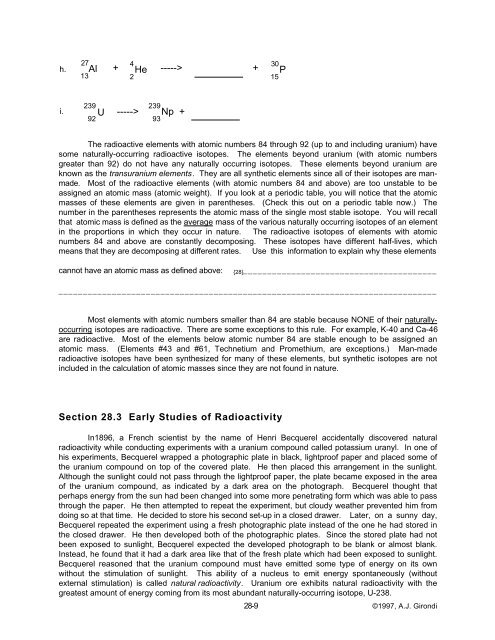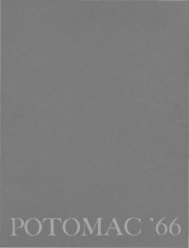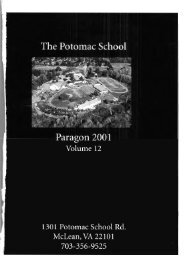Active Learning In Chemistry Education - Potomac School
Active Learning In Chemistry Education - Potomac School
Active Learning In Chemistry Education - Potomac School
You also want an ePaper? Increase the reach of your titles
YUMPU automatically turns print PDFs into web optimized ePapers that Google loves.
27<br />
h. Al<br />
13<br />
4<br />
+ He -----> +<br />
2<br />
30<br />
P<br />
15<br />
i.<br />
239<br />
U<br />
92<br />
239<br />
-----> Np +<br />
93<br />
The radioactive elements with atomic numbers 84 through 92 (up to and including uranium) have<br />
some naturally-occurring radioactive isotopes. The elements beyond uranium (with atomic numbers<br />
greater than 92) do not have any naturally occurring isotopes. These elements beyond uranium are<br />
known as the transuranium elements. They are all synthetic elements since all of their isotopes are manmade.<br />
Most of the radioactive elements (with atomic numbers 84 and above) are too unstable to be<br />
assigned an atomic mass (atomic weight). If you look at a periodic table, you will notice that the atomic<br />
masses of these elements are given in parentheses. (Check this out on a periodic table now.) The<br />
number in the parentheses represents the atomic mass of the single most stable isotope. You will recall<br />
that atomic mass is defined as the average mass of the various naturally occurring isotopes of an element<br />
in the proportions in which they occur in nature. The radioactive isotopes of elements with atomic<br />
numbers 84 and above are constantly decomposing. These isotopes have different half-lives, which<br />
means that they are decomposing at different rates. Use this information to explain why these elements<br />
cannot have an atomic mass as defined above:<br />
{28}________________________________________<br />
______________________________________________________________________________<br />
Most elements with atomic numbers smaller than 84 are stable because NONE of their naturallyoccurring<br />
isotopes are radioactive. There are some exceptions to this rule. For example, K-40 and Ca-46<br />
are radioactive. Most of the elements below atomic number 84 are stable enough to be assigned an<br />
atomic mass. (Elements #43 and #61, Technetium and Promethium, are exceptions.) Man-made<br />
radioactive isotopes have been synthesized for many of these elements, but synthetic isotopes are not<br />
included in the calculation of atomic masses since they are not found in nature.<br />
Section 28.3 Early Studies of Radioactivity<br />
<strong>In</strong>1896, a French scientist by the name of Henri Becquerel accidentally discovered natural<br />
radioactivity while conducting experiments with a uranium compound called potassium uranyl. <strong>In</strong> one of<br />
his experiments, Becquerel wrapped a photographic plate in black, lightproof paper and placed some of<br />
the uranium compound on top of the covered plate. He then placed this arrangement in the sunlight.<br />
Although the sunlight could not pass through the lightproof paper, the plate became exposed in the area<br />
of the uranium compound, as indicated by a dark area on the photograph. Becquerel thought that<br />
perhaps energy from the sun had been changed into some more penetrating form which was able to pass<br />
through the paper. He then attempted to repeat the experiment, but cloudy weather prevented him from<br />
doing so at that time. He decided to store his second set-up in a closed drawer. Later, on a sunny day,<br />
Becquerel repeated the experiment using a fresh photographic plate instead of the one he had stored in<br />
the closed drawer. He then developed both of the photographic plates. Since the stored plate had not<br />
been exposed to sunlight, Becquerel expected the developed photograph to be blank or almost blank.<br />
<strong>In</strong>stead, he found that it had a dark area like that of the fresh plate which had been exposed to sunlight.<br />
Becquerel reasoned that the uranium compound must have emitted some type of energy on its own<br />
without the stimulation of sunlight. This ability of a nucleus to emit energy spontaneously (without<br />
external stimulation) is called natural radioactivity. Uranium ore exhibits natural radioactivity with the<br />
greatest amount of energy coming from its most abundant naturally-occurring isotope, U-238.<br />
28-9 ©1997, A.J. Girondi













